Farming carbon
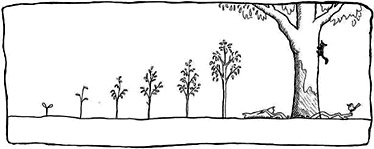
Potential to store carbon
- Above-ground carbon in brigalow vegetation is stored in living trees and shrubs, but also in dead standing trees, fallen timber and litter.
- Estimates of total above-ground biomass (living and dead) for mature brigalow forest in Queensland range from about 100 to just over 250 tonnes per hectare (equivalent to 50 to 125 tonnes of carbon per hectare or 180 to 458 tonnes of carbon dioxide equivalent per hectare).
- Dead trees and coarse woody debris can hold about as much above-ground carbon as living trees and shrubs in a mature brigalow forest. This stock of carbon in dead wood may take many centuries to accumulate and would be threatened by fire as well as trampling by large domestic stock.
- The estimated biomass accumulation rate of brigalow regrowth ranges from 1.3 to 4.6 tonnes per hectare per year for living biomass, and from 1.9 to 3.2 tonnes per hectare per year- for total biomass (living and dead). Biomass accumulation rates of 1.9 to 3.2 tonnes per hectare per year- equate to carbon accumulation of 3.3 to 5.5 tonnes of carbon dioxide equivalent per hectare per year.
Carbon farming might not always mean bringing brigalow vegetation back to its full carbon capacity as soon as possible. Some carbon returns might be traded off against other land uses, such as livestock grazing, which may limit carbon accumulation rates. Low to moderate levels of livestock grazing appear to be compatible with reforestation in brigalow vegetation.
Note: to generate carbon credits you will need to register a project with the Clean Energy Regulator using an approved method. The methods detail the conditions or rules for generating carbon credits (Australian Carbon Credit Units) and how vegetation is to be managed as part of a project.
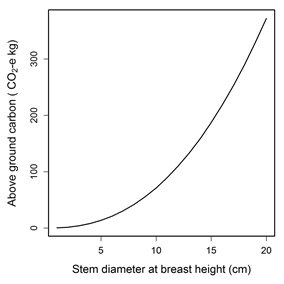
The relationship between brigalow stem diameter and the amount of above-ground carbon stored (expressed as carbon dioxide equivalents (CO2-e). Breast height = 1.3m. (after Scanlan 1991).
Carbon storage and tree size
Large trees hold far more carbon than small trees because the amount of carbon held increases exponentially as the trunk diameter of a tree increases. For example, the carbon held in an average large tree (e.g. 20cm stem diameter) is about the same as that held in 255 smaller trees (e.g. 2cm stem diameter).
| Tree dbh (cm) | Dry matter (kg) | Carbon (kg) | CO2 equivalent (kg) |
|---|---|---|---|
| 2 | 1 | 0.4 | 2 |
| 10 | 41 | 19 | 71 |
| 20 | 216 | 102 | 372 |
The approximate amount of above-ground dry matter, carbon and carbon dioxide equivalent stored in brigalow trees of different diameters. Dbh = stem diameter measured at 1.3m height.
Approximately the same amount of carbon is stored above-ground in:
- One x 20cm dbh tree;
- Five x 10cm dbh trees; or
- 254 x 2cm dbh trees.
Trade-offs between trees and pasture
Increasing the basal area of trees tends to result in decreased pasture yield. This has been observed for a variety of vegetation types in Queensland, including brigalow.
It should be possible to combine carbon farming of regrowth with livestock production, but landholders should consider how increased tree growth may impact on their pasture yield.
Retaining blocks or strips of trees within a paddock may provide opportunities to increase carbon storage while minimising the impact on pasture growth. Tree strips may provide some advantages by acting as a windbreak, which may help the growth of pasture beyond the competitive reach of tree roots.
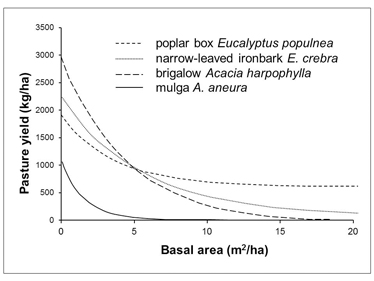
Relationships between tree basal area and pasture yield for a range of tree species from sites in Queensland (see Brigalow Management Guideline for details)
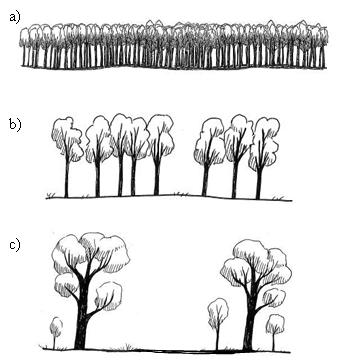
Grow big trees to maximise carbon
A few big trees can hold far more carbon than a large number of small or medium trees. So it is in the interests of carbon farming to maximise the height and diameter of existing trees, which may be achieved by reducing tree density in dense regrowth. This may involve the selective thinning of smaller trees, or allowing drought and competition among trees to result in natural rates of tree dieback and thinning.
Increasing tree basal area is still likely to reduce pasture yield, but a few large trees will hold far more carbon than many small ones, for the same basal area.
| Tree dbh (cm) | No. trees | Basal area (m2) | CO2 equivalent (kg) | |
|---|---|---|---|---|
| a) | 2 | 9549 | 3 | 14,324 |
| b) | 10 | 382 | 3 | 27,235 |
| c) | 20 | 96 | 3 | 35,533 |
Limits to carbon accumulation
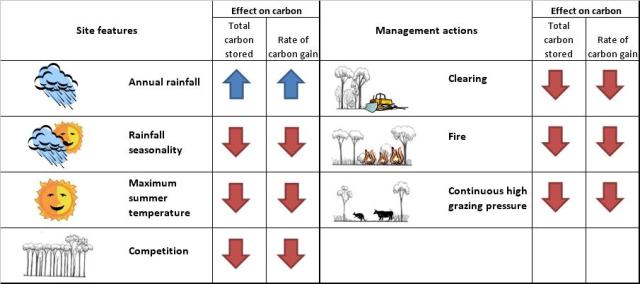
Carbon accumulation in brigalow is limited by rainfall, temperature, competition, clearing, fire, and continuous high grazing pressure.
The total amount of carbon stored by brigalow, and the rate it accumulates, can be maximised by removing these limits where possible.
Rainfall and temperature
Rainfall is needed for forest growth, and forests in wetter climates generally hold more living matter. Lower or more strongly seasonal rainfall, and higher maximum summer temperatures, have negative overall effects on rates of tree growth (and carbon accumulation).
Competition
Efforts to control brigalow often result in stands with high stem densities (e.g. ‘whipstick brigalow’). The apparently slow growth rates of these stands has led to concerns that carbon accumulation rates in brigalow vegetation will be slow when stem densities are high.
It is likely that lower stem densities (e.g. around 6000 stems per hectare rather than 15,000) will improve the rate of carbon accumulation, or the total carbon stored by brigalow vegetation in the longer term. However, thinning stem density to less than 2000 stems per hectare is likely to hamper carbon gain.
One of the difficulties of thinning brigalow is that the most rapid death of stems tends to produce the most vigorous suckering response. So the quickest and easiest methods of removing stems (e.g. by using loppers, a chainsaw, or small machinery, etc.) are likely to be the least effective in producing an overall reduction in stem density. To be effective, thinning has to be done by using methods that cause slow stem death (e.g. ringbarking, selectively using herbicide) and these are time and labour-intensive.
Clearing
Clearing brigalow will reduce the rate of carbon gain, decrease the capacity of the vegetation to store carbon, and produce a net carbon loss.
Fire
Hot fires result in net carbon loss by releasing the carbon stored in trees, shrubs, dead wood and litter.
Repeated, less severe fires reduce the rate of carbon gain by removing small trees and shrubs, and decrease the capacity of the vegetation to store carbon by limiting the recruitment of brigalow and other fire-sensitive species.
The risk of fire will depend on climate and fuel loads. More dense stands, that prevent areas of dense grass developing, should reduce the risk of destructive fires. Low-severity burns and/or grazing may be used to reduce the risk of hot fires where grass fuels are likely to accumulate.
Continuous high grazing pressure
Grazing may reduce carbon gain and storage by disturbing tree and shrub growth and establishment, and by trampling woody debris and litter.
However, grazing may be helpful in managing fire risks by reducing fine fuels loads.
Grazing may also reduce competition from grasses and increase the growth rates of brigalow.
Therefore grazing can be compatible with reforestation in brigalow, as long as grazing pressure is held at low to moderate levels, the trampling of litter and woody debris is minimised, and the death of mature trees is equal to the number of new trees growing into the canopy.
References
- Beale IF (1973) Tree density effects on yields of herbage and tree components in south west Queensland mulga (Acacia aneura F. Muell.) scrub. Tropical Grasslands 7, 135-142.
- Burrows WH (2002) Harry Stobbs Memorial Lecture, 2002. Seeing the wood(land) for the trees - An individual perspective of Queensland woodland studies (1965-2005). Tropical Grasslands 36, 202-217.
- Scanlan JC (1991) Woody overstorey and herbaceous understorey biomass in Acacia harpophylla (brigalow) woodlands. Australian Journal of Ecology 16, 521-529.
- Scanlan JC, Burrows WH (1990) Woody overstorey impact on herbaceous understorey in Eucalyptus spp. communities in central Queensland. Australian Journal of Ecology 15, 191-197.


